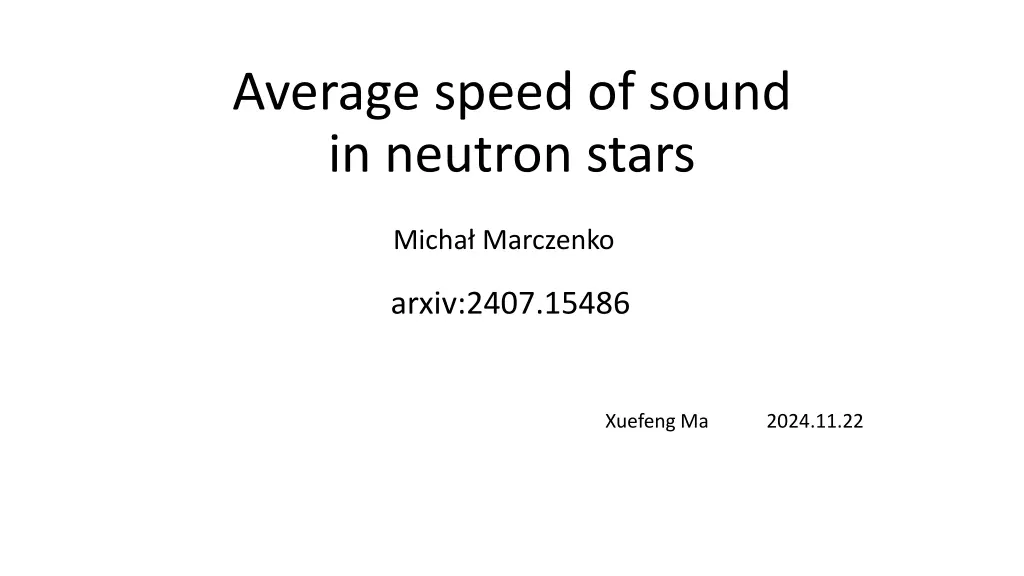
Average Speed of Sound in Neutron Stars: Consequences of Trace Anomaly
Explore how the vanishing trace anomaly affects the speed of sound in neutron stars. The equation of state, relationship between pressure and energy density, and the implications of the trace anomaly disappearance are discussed. Find out the consequences and connections in this intriguing study on neutron stars.
Download Presentation

Please find below an Image/Link to download the presentation.
The content on the website is provided AS IS for your information and personal use only. It may not be sold, licensed, or shared on other websites without obtaining consent from the author. If you encounter any issues during the download, it is possible that the publisher has removed the file from their server.
You are allowed to download the files provided on this website for personal or commercial use, subject to the condition that they are used lawfully. All files are the property of their respective owners.
The content on the website is provided AS IS for your information and personal use only. It may not be sold, licensed, or shared on other websites without obtaining consent from the author.
E N D
Presentation Transcript
Average speed of sound in neutron stars Micha Marczenko arxiv:2407.15486 Xuefeng Ma 2024.11.22
1.Introduction 2.Results 3.Summary
Introduction The equation of state(EOS): ?(?), provides a relationship between the thermodynamics pressure ? and the energy density ?. Speed of sound: ??2, its derivative with respect to the energy density. At low temperature, The low-density EOS chiral effective field theory; ??2< Asymptotically pQCD; ??2 1 3 1 3 The density range found in neutron stars (NSs) is not accessible by any of these methods.
Speed of sound exhibits a local maximum Rapid increase in the speed of sound beyond its conformal value in dense matter is associated with rapid disappearance of trace anomaly. What is the consequences of the vanishing of the trace anomaly?
Average speed of sound in neutron stars Speed of sound: ??2 ?? (1), 0 ??2 1 ?? Connection between the speed of sound and trace anomaly ??2=1 3 Where the trace anomaly scaled by the energy density reads =? 3? 3? and its derivative is ? ????= ?? (2) =1 3 ? (3) ? = (4) ??
Average speed of sound in neutron stars The ratio of the central pressure to the central density in NSs can be reinterpreted as the average speed of sound as follows: ??2=1 ? 0 the average speed of sound over energy interval 0,? , and 0 ??2 1. ? ? ?? ??2=1 ?? ?? ?? =? ? (5) ? 0 Using Eq.(5), rewrite Eq.(2) and (3) : =1 = ??2 ??2, 3 ??2, 6 (7) increases when ??2is smaller than ??2and decreases when ??2is larger than ??2.
Average speed of sound in neutron stars =1 = ??2 ??2, 3 ??2, 6 (7) The restoration of conformal symmetry requires a simultaneous convergence of ??2 and ??2to 1 3. The trace anomaly vanishes when ??2reaches exceed the conformal value at smaller energy densities. 1 3, which means that it must
Consequences of vanishing trace anomaly Assume that the trace anomaly vanishes at some finite energy density ??, ?= 0 If the EOS is known up to ??< ??, the average can be separated into two segments, Namely ?=1 ?? 0 ?? ?? ?? Where ??2 ????is the average speed of sound over the energy interval 0,?? and is assumed to be known, and 1 ?? ?? ?? 13 ??2 ?= ?? ?? ?? ?? ??2=1 ?? ??2+1 ??2 ?? ??2 ?? 0 ?? + ? 1 ?? =1 = ??2 (10) ? ?? 3 ?= ?? ??2 ? ??2 1 ???? ? ????2 ? = 11 ? = (12) ????
Results One can use the low-density EOS to determine the value of ? and estimate the lower bound for the maximum of speed of sound in the cores of NSs. ??2 ? ??2 1 ???? ? ? = (12) ???? The author requires that ??has to reproduce the estimated central energy density of maximally massive neutron stars, which yields ? = 0.41 0.49. Indicating that the speed of sound exceeds the conformal value at energy densities between ?? and ??.
Results Eq. (10) can also be used to estimate the minimal value of ??2 ?for which ? 1 3. Taking the same EFT constraint, ??2 ? 0.26 at the 95% confidence level of ????. ? 0.07 Consequences of vanishing trace anomaly The assumption that the trace anomaly is non-negative 0 ??2 1 3 Under the assumption that 0 at all densities, the average speed of sound cannot exceed 1/3 and the speed of sound must develop a local maximum above ??2=1 3 at energy density ? ??.
Summary The large speed of sound is a consequence of the restoration of conformal symmetry in the heaviest NSs. The existence of the peak in speed of sound could be potentially linked to the positive definiteness of the trace anomaly.
